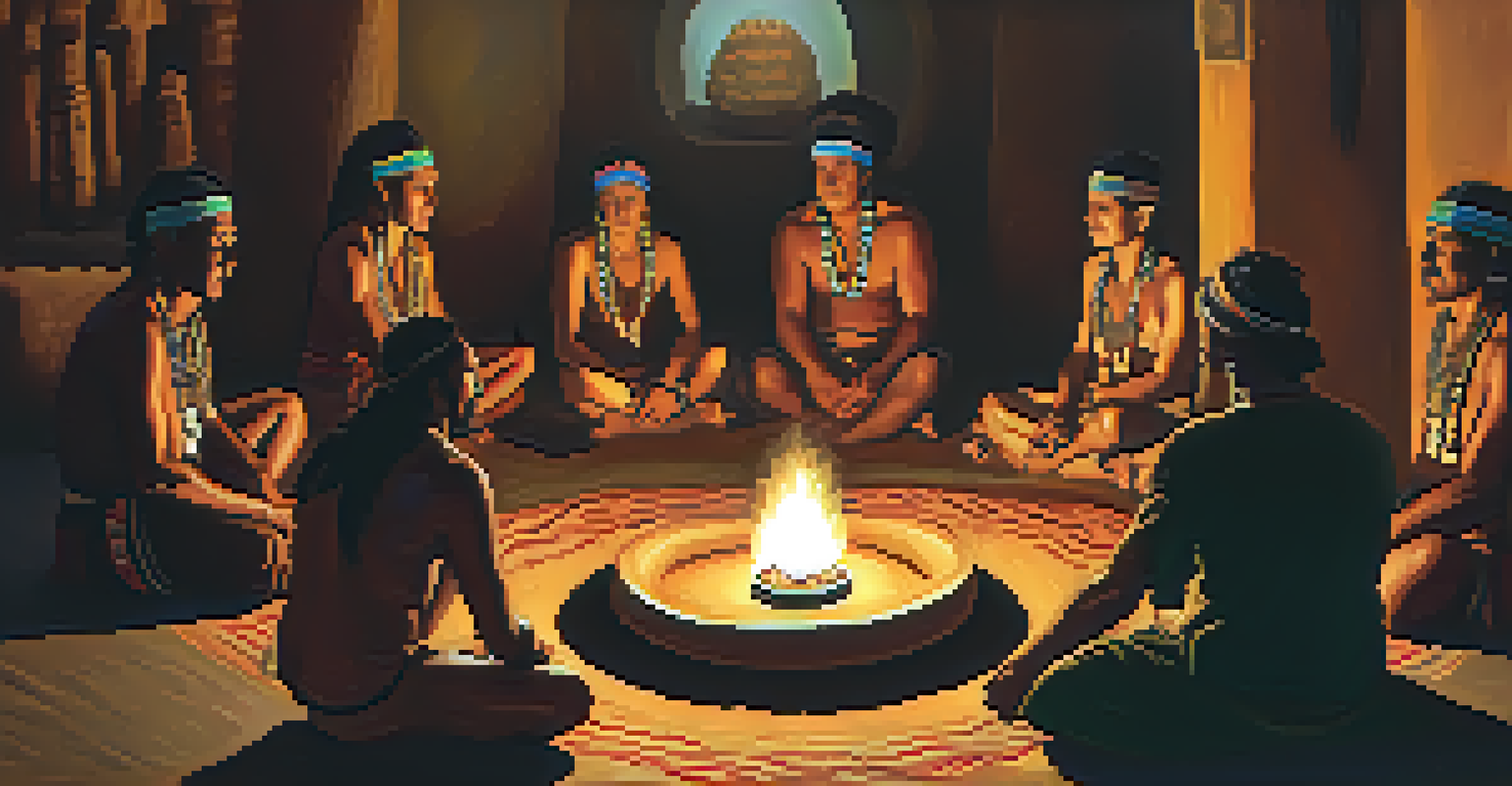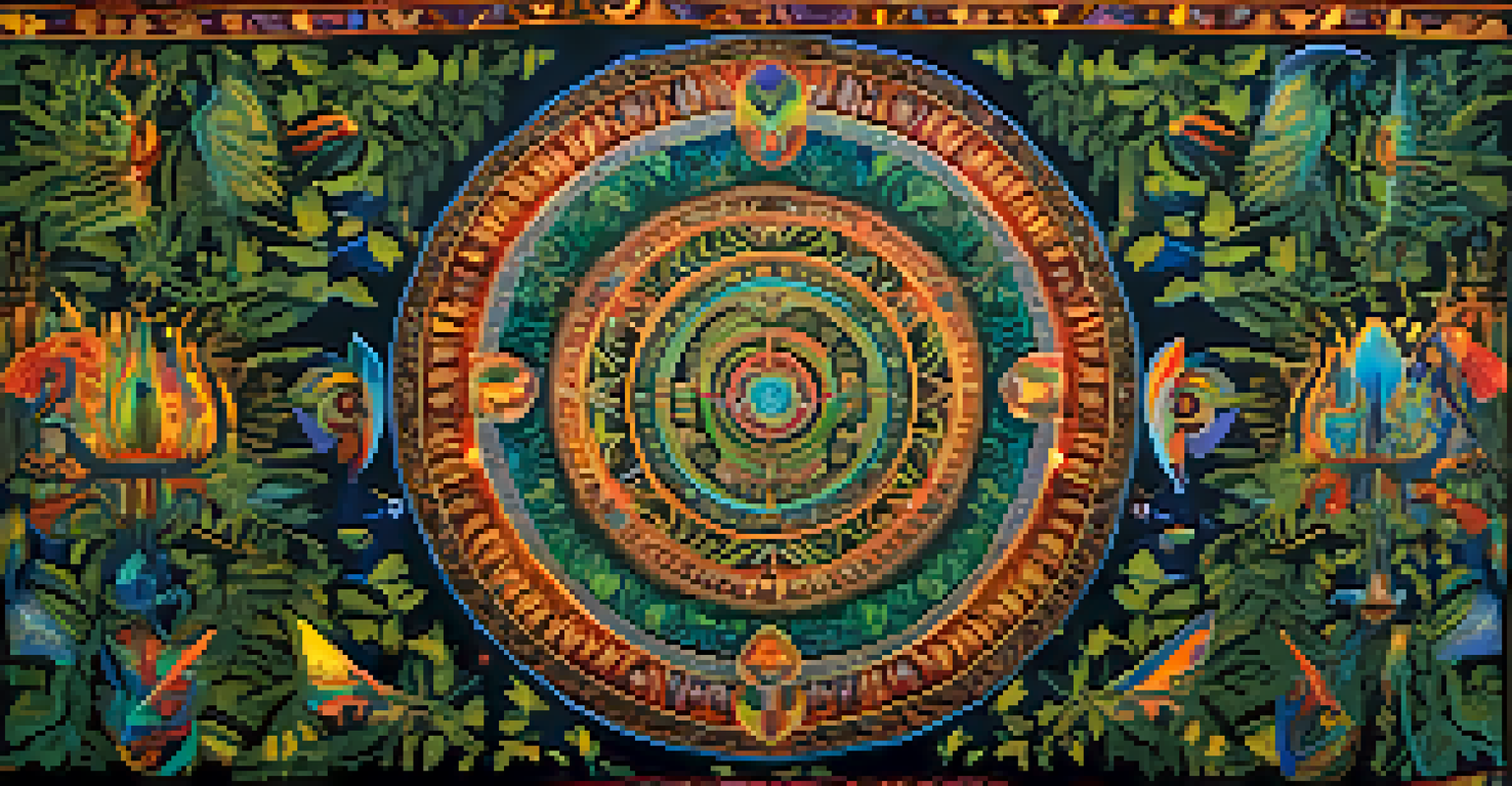Ayahuasca Ceremony: Steps and Rituals Involved

What is Ayahuasca and Its Cultural Significance?
Ayahuasca is a traditional Amazonian brew known for its psychoactive properties, primarily used in spiritual and healing ceremonies. This concoction is made from the Banisteriopsis caapi vine and the Psychotria viridis leaf, which together create a powerful experience. In indigenous cultures, it's regarded as a sacred medicine, connecting participants with the spiritual realm and their inner selves.
The experience of Ayahuasca is a journey into the depths of the self, where the spirit can find healing and transformation.
The cultural significance of Ayahuasca cannot be overstated. For centuries, it has been utilized by shamans and healers for both physical and mental health benefits, often seen as a rite of passage. The experience is deeply rooted in spirituality, where the participants seek insight, healing, and a greater understanding of their place in the universe.
With the growing interest in Ayahuasca beyond its native lands, many people are drawn to its transformative potential. However, this journey is not just about the drink; it involves a rich tapestry of rituals and practices that ensure a respectful and safe experience.
Preparing for the Ayahuasca Ceremony
Preparation for an Ayahuasca ceremony is crucial to maximize its benefits and minimize risks. Participants are often advised to follow a specific diet, known as the 'dieta,' which eliminates processed foods, alcohol, and certain substances. This not only helps cleanse the body but also enhances the experience during the ceremony.

Mental and emotional preparation is equally important. Attendees are encouraged to reflect on their intentions for the ceremony, which can guide their journey and foster a more meaningful connection with the Ayahuasca brew. Journaling or meditation can be beneficial practices leading up to the event.
Ayahuasca's Cultural Importance
Ayahuasca is a sacred Amazonian brew used in spiritual and healing ceremonies, connecting participants with their inner selves.
Additionally, it's wise to choose a reputable retreat or facilitator. Researching the background of the shaman or guide ensures that they possess the necessary experience and knowledge to lead a safe and supportive ceremony.
The Setting: Creating a Sacred Space
The environment where the Ayahuasca ceremony takes place is essential for fostering a safe and nurturing atmosphere. Typically, this occurs in a maloca, a traditional ceremonial hut that resonates with spiritual energy. The setting is often adorned with meaningful artifacts, such as feathers, crystals, and artwork, which contribute to the overall ambiance.
Ayahuasca offers a glimpse into the interconnectedness of all things, revealing profound insights that can lead to personal growth.
Lighting and sound play significant roles as well. Soft, dim lighting and calming music or chants can help participants feel at ease, allowing them to focus inward. The presence of nature, often surrounding these ceremonies, adds to the serene atmosphere, promoting a sense of connection to the earth.
Creating a sacred space also involves setting clear intentions and boundaries. Participants are encouraged to express their needs and fears, fostering an environment where everyone feels safe and supported throughout their journey.
The Role of the Shaman in the Ceremony
The shaman, or healer, plays a pivotal role in guiding participants through the Ayahuasca ceremony. With years of training and experience, the shaman is responsible for facilitating the experience, ensuring the safety and well-being of all attendees. Their knowledge of the brew and its effects is invaluable in navigating the journey.
During the ceremony, the shaman may sing icaros, traditional songs that help guide participants through their experiences. These chants, often imbued with spiritual significance, can evoke healing and transformation, helping individuals connect with their inner selves.
Preparation Enhances Experience
Proper preparation, including a specific diet and mental readiness, is essential for maximizing the benefits of an Ayahuasca ceremony.
Moreover, the shaman's presence provides comfort and reassurance. They are trained to handle various situations that may arise during the ceremony, from emotional breakthroughs to physical discomfort, ensuring that everyone feels supported throughout their journey.
Drinking the Brew: What to Expect
When it's time to consume the Ayahuasca brew, participants typically gather in a circle, creating a sense of community. The shaman serves the drink, and as everyone takes their turn, a collective energy begins to build. The anticipation can be quite palpable, with each person holding their own intentions and hopes for the experience ahead.
After drinking the brew, participants may start to feel its effects within 30 to 60 minutes. Common experiences include heightened emotions, visual and auditory phenomena, and deep introspection. While some may feel euphoric, others might confront challenging memories or feelings, which is a normal part of the healing process.
It's essential to approach these experiences with an open mind and heart, trusting the journey ahead. The emotional waves can be intense, yet many find that facing these challenges leads to profound insights and healing.
Navigating the Journey: Insights and Healing
As the effects of Ayahuasca unfold, participants often encounter vivid visions and emotions that can lead to significant insights. This process is unique for everyone, with some experiencing cathartic releases while others may receive messages or symbols that resonate deeply. It’s not uncommon to feel a sense of interconnectedness with others and the universe during this time.
Many participants describe the experience as a journey into their subconscious, where they confront unresolved issues or traumas. This can be challenging, but it often paves the way for healing and personal growth. Embracing these moments with curiosity rather than fear can enhance the transformational aspect of the ceremony.
Integration is Key Post-Ceremony
Post-ceremony integration through reflection and community support helps participants make sense of their experiences and foster personal growth.
Post-ceremony integration is vital to help make sense of the insights gained. Many retreat centers offer integration sessions or support groups, allowing participants to share their experiences and reflect on the lessons learned.
Post-Ceremony Integration and Reflection
After the ceremony, the experience doesn’t just end; integration is a key component of the Ayahuasca journey. Participants are encouraged to take time for reflection, often journaling about their experiences and insights. This practice helps to consolidate the lessons learned and can provide clarity on how to implement these changes in daily life.
Support from the community is also crucial during this phase. Many find comfort in discussing their experiences with fellow participants, allowing for collective healing and understanding. Sharing stories can help individuals feel less isolated and more connected to their journey.

Lastly, maintaining the changes brought about during the ceremony requires commitment and mindfulness. Participants may incorporate practices such as meditation, yoga, or therapy into their routines to continue their personal growth and healing.